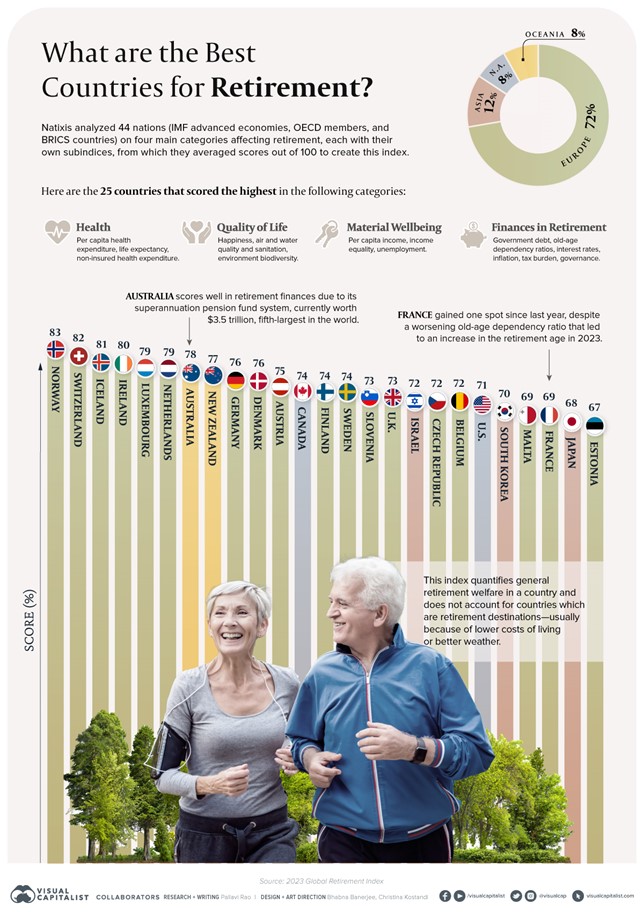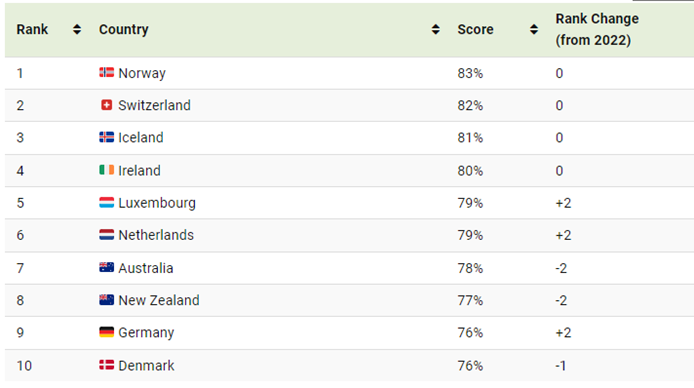RANKED: The Top 25 Countries for Retirement

In 1881, Otto von Bismarck proposed a radical idea for retirement: people above the age of 70 would be given a state pension, encouraging them to stop working.
This model has since been adopted en masse and most countries now have a retirement age, after which workers can claim benefits paid through years of their work.
However, modern-day retirement is much more than just finances. Wealth management company Natixis analyzed 44 nations on four main categories affecting the ability for their residents to retire well in the 2023 Global Retirement Index. Each category has subindices, from which they averaged scores out of 100 to create this ranking.
The categories are:
- Health: Per capita spend on healthcare, life expectancy, and non-insured health spend.
- Quality of Life: Happiness levels, water and sanitation, air quality, environment, and biodiversity.
- Material Well-being: Per capita income, income equality, and employment levels.
- Retirement Finances: Government debt, old-age dependency, interest rates, inflation, governance, taxes, and bank non-performing loans.
* This index quantifies general retirement welfare in a country and does not account for countries which are retirement destinations—usually because of lower costs of living or better weather.
So, with one-third of the world expected to be 65 and older by 2050, how are countries stacking up against each other when it comes to creating supportive environments for retirement?
Of the countries analyzed for the best retirement conditions, here are the top 25.

What Are the Best Countries for Retirement?
Norway ranks first as the best country for retirement in this study, helped by top scores in health and material well-being.
For health metrics, Norway was one of the few countries to see life expectancy improve over the pandemic. It now sits at 83.3 years at birth, and is one of the highest rates in the world. This is in contrast to many other countries in the index (Canada, Austria, the U.S.) that saw life expectancies drop recently due to the higher mortality rate during the pandemic.
For well-being, Norway’s current low unemployment rate (3.8%) reduces undue pressure on their social security net.
In fact, Norway along with the next top three countries (Switzerland, Iceland, and Ireland) all retain their rankings from last year, along with Estonia, which is ranked 25th. Every other country gained or lost a spot as seen below.

Other highlights in the top 25 include: Australia, at 7th, which is the highest-ranked non-European country in the index. The country scores well in retirement finances due to its superannuation pension fund system, currently worth $3.5 trillion, fifth-largest in the world.
Meanwhile, France, just outside the top 20, saw widespread protests in early 2023 when a law to raise the retirement age to 64 was passed through special constitutional powers. Raising the retirement age will presumably keep people working longer, paying mandatory payroll tax to fund retirement benefits, and will improve their steadily worsening old-age dependency ratio.
A worsening old-age dependency ratio is where the share of older, dependent people to younger, employed people keeps increasing, reducing the sustainability of retirement benefits.
How Countries are Preparing for the “Silver Tsunami”
France is not the only country trying to keep its population working longer. The Chinese government is also looking to raise its retirement age in gradual shifts, as it grapples not only with an aging population but also a declining one.
Immigration has also been frequently cited as a near-term measure to boost the working-age population and increase the benefits pool. Canada, for example, had 6 workers for every retiree in 1980. In 2015 that had dropped to 4. By 2030, it will drop further to 3. As a result the country has pursued aggressive immigration for more than a decade now and has grown its population by 10 million since 2010.
Finally, there has been a push towards increasing overall productivity by targeting technological advancements and automation. However both need to occur in tandem with re-skilling so that they don’t result in net job losses, which will only further burden social security systems.
Sources:
https://www.visualcapitalist.com/top-25-countries-for-retirement-in-2024/
https://www.visualcapitalist.com/retirement-age-by-country/
https://www.im.natixis.com/sg/resources/2023-global-retirement-index-full-report
https://www.visualcapitalist.com/charted-american-life-expectancy-trends-2023/
https://www.visualcapitalist.com/best-countries-to-retire-in-2022/
https://www.visualcapitalist.com/cp/visualizing-the-changing-world-population-by-country/
